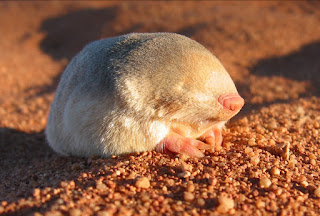
Golden moles are small burrowing insectivorous mammals that are endemic to southern Africa; They comprise the Chrysochloridae family and, as such, differ taxonomically from true moles, the Talpidae family, and other mole-like families, all of which resemble each other to varying degrees due to evolutionary convergence. There are 21 types of golden moles. 11 out of 25 species of golden mole are endangered due to habitat loss and because they are often killed by cats and dogs.
Golden moles burrow into the ground and live solitary lives, interacting with other golden moles only during mating season.
Golden mole is a tiny creature. It reaches 3.9 inches in length and 1.23 ounces of weight.
They have torpedo-shaped bodies, pointed noses, no external ears, and no tail, which allows them to move swiftly through the ground.
Body of the golden mole is covered with silky cinnamon-brown fur that is getting darker toward the back and paler toward the belly.
They are covered with thick, tough skin that protects them while they squeeze and scrape through tight spots.
Golden moles are highly specialized for the underground life. They have muscular shoulders and short, but strong legs, equipped with curved claws, designed for digging of the tunnels. Webbed hind legs allow shoveling in backwards.
Their short but strong front legs with curved claws make them very effective diggers.
Golden mole has non-functional eyes due to absence of light under the ground.
They even have webbed back feet that act like shovels to push dirt backwards.
Golden mole has excellent sense of touch and hearing, used for detection of vibrations that may signal potential danger.
The eyes of these creatures are covered by skin so that they are totally blind.
Species of golden moles which live in desert area “swim” through the loose sand and form visible ridges on the surface of the sand. Those that inhabit more compact terrains dig permanent underground burrows, which are complex and consist of deep chambers designated for the rest and for the personal hygiene (something like toilets).
The golden moles are aptly named for their fur, which despite varying in colour from yellow to black, usually has an iridescent sheen of coppery gold, purple, green or bronze.
Golden moles are insectivores which eat different kind of insects, earthworms and snails. Termites are their favorite foods.
Despite resembling true moles in appearance, golden moles are in fact more closely related to an ancient group of African mammals which includes the elephants, sea cows, hyraxes, aardvark, sengis and tenrecs.
Golden mole has very low metabolic rate and may enter the state of torpor (kind of temporary hibernation) which preserves energy. Torpor is usually associated with extreme weather conditions and with a resting time.
They create two types of burrow system: tunnels close to the surface that are used for foraging and deeper tunnels that are used for resting and raising their young.
Golden mole can switch off its termo-regulation when resting. This is another mechanism used for conservation of the energy. It was considered to be very primitive feature, but modern techniques of analysis showed that golden moles developed this mechanism recently, as an adaptation to a life in harsh environment.
Unlike true moles, golden moles do not push soil up into mounds, but rather create conspicuous ridges of soil above their tunnel systems.
Recent genetic analyses showed that golden moles belong to the ancient group of African mammals, called Afrotheria. Golden moles are more closely related to elephants, hyraxes and sea cows than with the true moles.
Golden moles have five toes on their webbed hind feet that help them push away dirt as they tunnel underground.
Golden moles are rarely seen in the wild because they are very small, live underground and because they are active only during the night. Scientists collected majority of information about them by examining carcasses of golden moles isolated from the stomach content of owls.
They eat earthworns, millipedes, termites and other insects.
Golden moles are solitary creatures which gather only during mating season. During that period, they produce sounds such as squeals and clicks.
Dominant individuals may subsume a rival’s tunnel within their home range.
Mating season takes place during October and November. Pregnancy lasts four to six weeks and ends up with one or two hairless babies.
Golden moles are believed to be polygynous and breed during the winter months of April to July.
Babies are kept in the burrows for a long period of time (until they gain enough weight) before they are ready to emerge to the surface. Mother is very protective and she aggressively defends her burrow.
Males and females exchange chirping and squealing calls; the male shakes his head, stamps his feet and pursues the female.
Average lifespan of the golden mole is unknown.
Eleven out of 21 species were under threat of extinction, according to the year 2002 IUCN Red List.










Thanks for sharing. I read many of your blog posts, cool, your blog is very good.